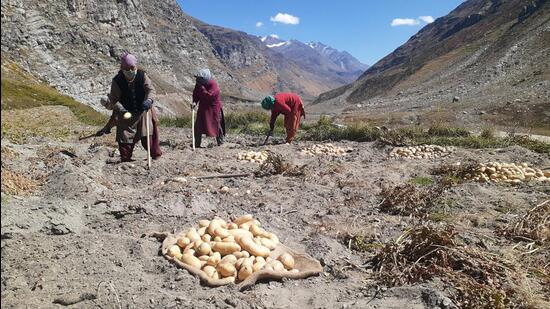The Central Potato Research Institute (CPRI) has issued an advisory to potato farmers across India, warning of a high risk of late blight disease due to changes in weather conditions. The disease, caused by the fungus Phytophthora Infestans, is a significant threat to potato crops, leading to substantial yield losses and reduced tuber quality.
Weather Conditions and Disease Risk
Institute director Brajesh Singh highlighted that the Indo-Blight cast (pan-India) model has predicted a high likelihood of late blight disease this year, similar to the previous year. Cool, moist weather conditions favor the spread of this disease, making timely management crucial to prevent outbreaks.
Preventive Measures and Fungicide Recommendations
General Precautions:
Singh emphasized the importance of proactive management. Farmers are urged to take necessary precautions and follow the advisory to ensure a healthy and productive crop.
For Asymptomatic Crops:
Farmers who have not yet sprayed fungicide or whose crops are not showing symptoms should immediately spray fungicide containing mancozeb chlorothalonil at a rate of 0.2% (2 kg in 1,000 liters of water per hectare) on disease-susceptible varieties.
For Symptomatic Crops:
In fields where symptoms of the disease have appeared, farmers are advised to spray specific fungicides:
- Cymoxanil + Mancozeb: 3 kg per hectare (1,000 liters of water)
- Fermion + Mancozeb: 3 kg per hectare (1,000 liters of water)
- Dimethomorph + Mancozeb: 1 kg of dimethomorph with 2 kg of mancozeb (total mixture 3 kg) per hectare (1,000 liters of water)
Application Frequency and Additional Tips:
- Repeat fungicide spraying at intervals of 10 days, depending on disease intensity.
- Avoid repeated use of the same fungicide to prevent resistance.
- Use a sticker (0.1%) with the fungicide to enhance effectiveness.
- Ensure proper drainage in fields and control weed growth to reduce disease risk.
Importance of Himachal Pradesh in Potato Production
Climatic Advantages:
Himachal Pradesh has emerged as a major hub for potato production, covering approximately 14,685 hectares, which accounts for about 20% of the state’s total vegetable cultivation area. The region’s cool temperate climate, high wind velocity, and moderate humidity, especially in the higher hills, create an ideal environment for cultivating disease-free, high-quality potato seeds and table potatoes.
Low Aphid Population and High-Quality Production:
The low aphid population in Himachal Pradesh contributes to the production of disease-resistant potatoes, making the state a prime location for seed potato production. The state’s potatoes are known for their high dry matter content, reaching up to 20%, which is essential for producing quality chips.
Economic Importance and Growth Potential:
Potato cultivation is a lifeline for many farmers in Himachal Pradesh, with around 80% of the cultivated area relying on rainfed agriculture. The Lahaul Valley, a cold desert in Himachal Pradesh, stands out as a significant area for potato production, specializing in prized seed potato varieties such as Kufri Chandramukhi, Kufri Jyoti, Table Santana, and Shafordi.
Experts believe that the state’s potato production has immense growth potential and can significantly contribute to the country’s food security.
Multiple-Choice Questions (MCQs):
- What is the primary cause of late blight disease in potato crops?
- a) Bacterial infection
- b) Viral infection
- c) Fungal infection
- d) Insect infestation
- Answer: c) Fungal infection
- Which fungicide combination is recommended for fields where symptoms of late blight disease have appeared?
- a) Mancozeb + Chlorothalonil
- b) Cymoxanil + Mancozeb
- c) Carbendazim + Mancozeb
- d) Tricyclazole + Mancozeb
- Answer: b) Cymoxanil + Mancozeb
- What is the ideal rate of fungicide application for mancozeb chlorothalonil in asymptomatic crops?
- a) 1 kg per hectare
- b) 2 kg per hectare
- c) 3 kg per hectare
- d) 4 kg per hectare
- Answer: b) 2 kg per hectare
- Why is Himachal Pradesh suitable for potato production?
- a) High temperature and humidity
- b) Low aphid population and cool temperate climate
- c) Sandy soil and high rainfall
- d) Proximity to major markets
- Answer: b) Low aphid population and cool temperate climate
- Which valley in Himachal Pradesh is known for cultivating prized seed potato varieties?
- a) Kullu Valley
- b) Spiti Valley
- c) Lahaul Valley
- d) Kangra Valley
- Answer: c) Lahaul Valley
